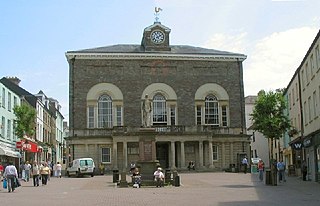
Carmarthenshire is a county in the south-west of Wales. The three largest towns are Llanelli, Carmarthen and Ammanford. Carmarthen is the county town and administrative centre. The county is known as the "Garden of Wales" and is also home to the National Botanic Garden of Wales.
Ronald Welch was the pseudonym of Welsh writer Ronald Oliver Felton TD, who wrote in English. He is best known for children's historical fiction. He won the 1956 Carnegie Medal from the Library Association for the year's best children's book by a British author, for Knight Crusader, the first in his so-called Carey Family series of novels.

Llansteffan, is a village and a community situated on the south coast of Carmarthenshire, Wales, lying on the estuary of the River Tywi, 7 miles (11 km) south of Carmarthen.
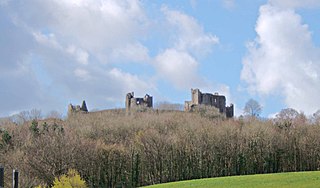
Llansteffan Castle is a privately owned castle in Llansteffan, Carmarthenshire, Wales, overlooking the River Tywi estuary in Carmarthen Bay.
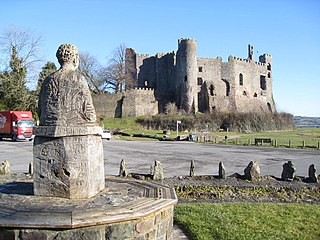
Laugharne Castle is in Laugharne, Carmarthenshire, Wales. The castle, located on the estuary of the River Tâf, was originally established in 1116. It was rebuilt as a Norman stronghold. There have been many alterations since then, including becoming a Tudor fortified manor house in the sixteenth century. It changed hands twice during the English Civil War, being eventually captured by Parliamentary forces in 1644.

Llangain is a village and community in Carmarthenshire, in the south-west of Wales. Located to the west of the River Towy, and south of the town of Carmarthen, the community contains three standing stones, and two chambered tombs as well as the ruins of 15th century great house, Castell Moel. In 2001 the community's population was recorded at 574, decreasing slightly to 573 at the 2011 census.

Maurice FitzGerald, Lord of Maynooth, Naas, and Llanstephan (born: almost certainly not at Windsor Castle, more likely Carew in Wales c.1105 – September c.1176 Wexford, Ireland. He was a medieval Anglo-Norman baron and a major figure in the Norman Invasion of Ireland.

Llangynog is a small rural community located in Carmarthenshire, Wales the main settlement of which was once called ‘Ebenezer’village. It is bordered by the communities of: Newchurch and Merthyr; Carmarthen; Llangain; Llansteffan; Laugharne Township; and St Clears, all being in Carmarthenshire. The population at the 2011 census was 492.
This article is about the particular significance of the year 1788 to Wales and its people.

Owen Cosby Philipps, 1st Baron Kylsant was a British businessman and politician, jailed in 1931 for producing a document with intent to deceive.
This is a list of High Sheriffs of Carmarthenshire. Carmarthenshire was originally created by the Statute of Rhuddlan in 1284. It became an administrative county in 1889 with a county council following the Local Government Act 1888. Under the Local Government Act 1972, the administrative county of Carmarthenshire was abolished on 1 April 1974 and the area of Carmarthenshire became three districts within the new county of Dyfed : Carmarthen, Dinefwr and Llanelli. Under the Local Government (Wales) Act 1994, Dyfed was abolished on 1 April 1996 and the three districts united to form a unitary authority which had the same boundaries as the original Carmarthenshire but remaining in the shrievalty of Dyfed.
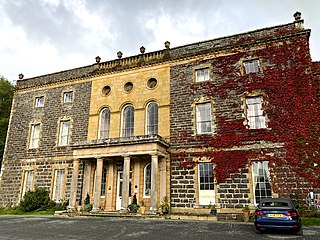
Nanteos is an 18th-century former country house in Llanbadarn-y-Creuddyn, near Aberystwyth, Ceredigion, Wales. A Grade I listed building, it is now a country house hotel. The gardens and parkland surrounding the mansion are listed on the Cadw/ICOMOS Register of Parks and Gardens of Special Historic Interest in Wales.

Castell Moel is the remains of a 16th-century fortified manor house in the community of Llangain in Carmarthenshire, Wales, and also a medieval motte about 600 yards (550 m) to the south of the manor house. The remains are approximately 2.5 miles (4.0 km) south-west Carmarthen and 0.8 miles (1.3 km) north-east of the village of Llangain. Three miles to the north-west is Carmarthen Castle, and five miles to the south-west is Llansteffan Castle.

Castle House in Laugharne, Carmarthenshire, Wales, is a Grade II*–listed Georgian mansion. Described by Dylan Thomas as “the best of houses in the best of places”, it is one of many buildings of note in the medieval township.
Slebech was a community in Pembrokeshire, Wales, which is now part of the combined community of Uzmaston and Boulston and Slebech, a sparsely populated community on the northern shore of the Eastern River Cleddau. The community shares boundaries with the communities of Wiston and Llawhaden and mainly consists of farmland and woodland. Much of the community is within the Pembrokeshire Coast National Park and Picton Castle's stable block loft is an important breeding roost for the rare Greater Horseshoe Bat.

In the United Kingdom, the term listed building refers to a building or other structure officially designated as being of special architectural, historical, or cultural significance; Grade I structures are those considered to be "buildings of exceptional interest". Listing was begun by a provision in the Town and Country Planning Act 1947. Once listed, strict limitations are imposed on the modifications allowed to a building's structure or fittings. In Wales, the authority for listing under the Planning Act 1990 rests with Cadw.
The first election to the Carmarthenshire County Council was held in January 1889. It was followed by the 1892 election.
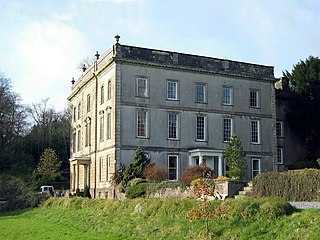
Plas Taliaris is a Grade I-listed building two miles to the north-east of Salem in Carmarthenshire, west Wales. It was first mentioned in 1336 and was owned by the Gwynne family until the house was sold in 1787. Most of the estate was sold in the 1950s and the house was restored in around 1989. Its gardens and park are registered on the Cadw/ICOMOS Register of Parks and Gardens of Special Historic Interest in Wales.

Amroth Castle is a Grade I listed building in Pembrokeshire, Wales. It is a castellated country house dating mainly from the 18th century built on an earlier, probably 15th century, residence, and is now a holiday venue.
Cwmgwili is a country house set in its own grounds approximately 2.5 km (1.6 mi) northwest of Abergwili in Carmarthenshire, Wales. It was probably built in the late sixteenth century.













